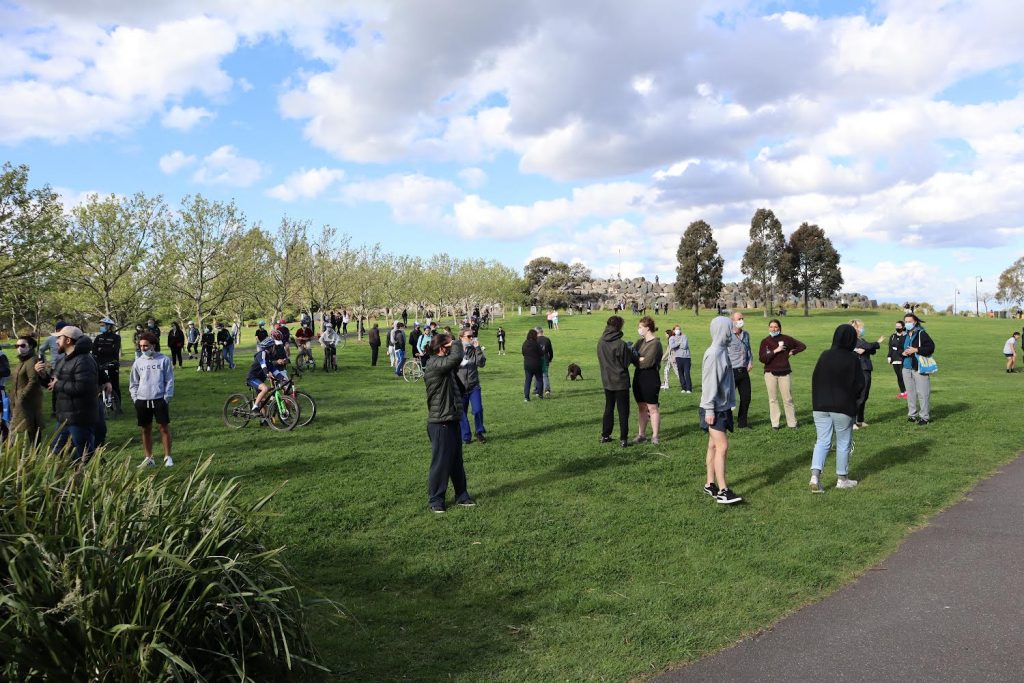The recent case of Novak Djokovic is a classic introduction to Australian administrative law.
It also shows what a mess our Federal system has made of vaccination policies.

I have been fascinated to read what the press and the politicians have had to say about Australian administrative law as it has applied to the case of Novak Djokovic v Minister for Home Affairs. It has been difficult to work out what has actually happened from these press releases and political statements alone.
Fortunately, light has now been shed on what has happened. That’s because a Court decision in this case was made yesterday, on 10 January 2022, and can be found here.
I have not been involved in this case, and I have only read the Court documents and some press on the issue. This post is a comment on some of the administrative law aspects of the case. It is also a comment on some of the mandatory vaccination rules applying in Victoria and the Commonwealth.
Federal not Victorian law
Judge A Kelly of the Federal Circuit and Family Court of Australia (FCFCA) was the presiding judge in this case. This was a Federal case, not a Victorian case. It related to a decision made under Commonwealth law, not Victorian law. It applied legislation passed by the Commonwealth Parliament, not legislation made by the Victorian parliament.
The first things to be considered here, are things I constantly explain in my training courses to public servants and bureaucrats across both Federal and State systems (and, yes, these things are relevant to local government decision making too).
Key questions to ask
Q1: Who made what decision which is being complained about?
Q2: What legislation authorised this decision?
Q3: What discretions and constraints applied to the making of the decision? and
Q4: What errors of law were made by the decision maker?
Before we walk through these questions, it is worth clarifying a very important further question.
Q5: What did the judge do?
Q5: What did the judge do about Djokovic’s visa cancellation?
Judge Kelly did not analyse the case and hand down a decision with reasons.
Rather, the parties (Mr Djokovic and the Minister for Home Affairs) came to an agreement, and asked the Judge to make orders which reflected the agreement. These are usually called “consent orders”. The Judge is supposed to be comfortable with making such orders, but it’s not the same as the Judge forming a view about all legal and factual issues in the case.
As noted above, the orders can be found on the Court’s website, through the link here. The orders are summarised here:
- The decision of a delegate of the Minister to cancel the applicant’s visa was quashed;
- The Minister pays the applicant’s costs; and
- The Minister releases the applicant from immigration detention within 30 minutes, and returns his passport and personal effects to him.
That’s it. There are no reasons, because these orders were made by consent.
However, there is an interesting “Notation”.
Judge’s Notation shows that the Minister conceded defeat and Djokovic was treated unfairly
The Notation states that the decision was conceded by the respondent to be unreasonable.
It was conceded to be unreasonable because:
“The respondent concedes that the delegate’s decision to proceed with the
interview and make a decision to cancel the applicant’s visa pursuant to
s 116 of the Migration Act 1958 (Cth) was unreasonable in circumstances
where:
(1) at 5:20am on 6 January 2022 the applicant was told that he could have until 8.30am to provide comments in response to a notice of intention to consider cancellation under s 116 of the Migration Act 1958 (Cth);
(2) instead, the applicant’s comments were then sought at about 6:14am.
(3) the delegate’s decision to cancel the applicant’s visa was made at 7.42am;
(4) the applicant was thus denied until 8.30am to make comments;
(5) had the applicant been allowed until 8:30am, he could have consulted others and made further submissions to the delegate about why his visa should not be cancelled.”
In general administrative law terms, these facts show a breach of natural justice, or procedural fairness. (In the context of the Migration Act, the term used here is “unreasonable”.)
A breach of natural justice is when somebody is treated unfairly in terms of the process, not the outcome. This means that the decision involves an error of law, due to a fundamental breach of fair process.
In this case, the applicant, Mr Djokovic, was told that he had 3 hours to provide comments, and then that promise was ‘removed’ and the opportunity was denied to him. It was so early in the morning that he had no chance to speak to his lawyers or others. He was expecting to have until 8.30 am, but that expectation was not fulfilled.
This is why the Minister conceded that the visa cancellation was a legally flawed decision.
And that is why the Minister told the judge that another visa cancellation might occur shortly. The Judge noted that:
“The Court was informed… that the Minister for Immigration, Citizenship, Migrant Services and Multicultural Affairs may consider whether to exercise a personal power of cancellation pursuant to sub-section 133C(3) of the Migration Act 1958 (Cth).”
Fundamental questions we can ask
So, back to the other 4 questions I posed earlier. These are questions an administrative lawyer asks. They can also be asked by anybody complaining about a decision made by the government:
Q1: Who made what decision which is being complained about?
Q2: What legislation authorised this decision?
Q3: What discretions and constraints applied to the making of the decision? and
Q4: What errors of law were made by the decision maker?
Q1: Who made what decision which is being complained about?
The decision was made by a delegate of the Minister for Home Affairs. It doesn’t really matter what the name of this person was, because the decision is seen as a decision of the Minister. (This is why the Minister becomes the respondent in the case.)
The decision was a decision to cancel a visa granted to Novak Djokovic under the Migration Act before he came to Australia. It was called a subclass GG408 (Temporary Activity) visa.
Q2: What legislation authorised this decision?
An affidavit of Natalie Bannister, solicitor, (an excellent lawyer I used to work with at Blake Dawson Waldron, now called Ashurst), shows that the decision to cancel the visa was ‘purportedly’ made under 116(1)(e)(i) of the Migration Act.
Note that lawyers use terms like ‘purported’ decision to signal that the decision is not a lawful decision, if it contains an error of law. And a breach of natural justice is an error of law.
Q3: What discretions and constraints applied to the making of the Djokovik decision?
It can be seen from the Bannister affidavits (available on the Court website) that there were a number of arguments being put about the discretions and constraints applying to a decision under s 166(1)(e)(i) of the Migration Act.
I will not set all of those arguments here. They might become relevant in a future case if another visa cancellation decision is made.
The statutory provision states that the Minister may cancel a visa for different reasons, including this one:
(e) the presence of its holder in Australia is or may be, or would or might be, a risk to:
(i) the health, safety or good order of the Australian community or a segment of the Australian community; or
(ii) the health or safety of an individual or individuals; …
(s 116(1)(e)(i) Migration Act).
So it appears that s 166(1)(e)(i) of the Migration Act is the key statutory provision in the Djokovic case.
Not a Victorian provision.
Nor a policy.
And not a freestanding ‘rule’.
Q4: What errors of law were made by the decision maker?
The errors of law allegedly made by the decision maker are set out in the Bannister affidavits. Ms Bannister comments on the statutory provisions and the delegate’s failure to exercise the right discretions and comply with the necessary constraints.
But these are only allegations, as the matter was resolved by consent on the ‘unreasonableness’ ground alone.
What about the Prime Minister’s tweet that Djokovic had to follow the rules?
It is reported that the Prime Minister, Mr Scott Morrison, tweeted that “Rules are rules”:
“Mr Djokovic’s visa has been cancelled,” Morrison said in a tweet. “Rules are rules, especially when it comes to our borders. No one is above these rules. Our strong border policies have been critical to Australia having one of the lowest death rates in the world from COVID, we are continuing to be vigilant.”
However, there have been quite a few different comments made in the press regarding who made what decision about what, and who was responsible for what, and whether a vaccine exemption was provided or not, and to whom. A compilation of some of these different messages from the PM are set out in this youtube video.
At the end of the day, it is not the public statements of politicians that determine what decisions have been made by whom under what authority.
You need to look at the primary documents.
What about Tennis Australia?
There has been a lot of discussion by the politicians and the press about Tennis Australia. Things were said like “Tennis Australia granted an exemption”.
As an administrative lawyer, I ask myself, what status has Tennis Australia to make decisions or grant exemptions in relation to what?
In terms of entry to Australia, it is not a Commonwealth entity with statutory powers to grant or refuse entry.
In terms of entering or doing things in Victoria, it is not a State Government entity with statutory powers.
According to Tennis Australia’s website, and its Annual Report:
TENNIS AUSTRALIA – THE COMPANY AND GOVERNANCE STRUCTURE
Tennis Australia (TA) is a not-for-profit Company limited by guarantee and registered in Australia. The Company’s purpose is to grow, manage, promote and showcase the game of tennis domestically and represent Australia’s
tennis interests internationally. The Australian Open is owned and organised by TA each year at Melbourne Park. The members of TA are the six state and two territory tennis associations also known as the Member Associations (MAs).
So there you have it. Tennis is extremely important to Victoria and Australia, and the world. But Tennis Australia is a not-for-profit company, not an arm of government.
Therefore any decisions made by Tennis Australia about ability to play or requirements to get injections in the Australian Open only relate to players playing or seeking to play in the Australian Open.
And, of course, Tennis Australia is subject to the laws of Victoria and the Commonwealth, just like any other company in the country.
Tennis Australia’s affidavit and the ‘independent review’ of Djokovic’s claimed exemption
However, Dr Broderick, the ‘Chief Medical Officer’ (not a government title) of Tennis Australia filed an affidavit in the Djokovik case, saying that:
- she was involved in setting up an independent expert medical review panel for Tennis Australia (note, this is not a government panel);
- it was put in place in discussion with the Victorian Government’s Department of Health;
- Tennis Australia’s panel ‘decisions’ were then reviewed by the Department of Health’s independent panel;
- both panels were reviewing “whether or not the application met ATAGI’s guidelines on medical exemptions to vaccination (ATAGI is the Australian Technical Advisory Group on Immunisation); and
- both panels agreed that Djokovic should get an exemption.
Comment on the Tennis Australia and Department of Health two tier review panel process
This so-called medical exemption appears to have no legal force at all.
As far as Tennis Australia goes, they can, as a company, do what they like in terms of allowing players or not – subject to the laws of Australia and Victoria.
As far as the Department of Health goes, it does not appear that the panel allegedly established or endorsed by public servants in the Department had any legal force at all.
If there is something I do not know (which has not been published), I stand to be corrected.
But on this issue, I do note that the panels only looked at whether the exemption application met with the guidelines of a body (ATAGI) with no statutory force on these questions.
What could be the legal force of that?
What role did Daniel Andrews, the Premier of Victoria, play?
It’s not clear what role the Victorian Premier played in this saga, although I do recall seeing him on television referring to the independent two tier panel review process, described in Dr Broderick’s affidavit. He gave the impression that this was a government exemption decision.
I cannot see how it could possibly have been a government exemption in the sense of relating to any statutory powers of the Victorian government or public servants with statutory powers under any state government statutory regime.
The more relevant question, which I have not seen discussed, is whether Novak Djokovic falls within an exemption category to the applicable mandatory vaccination direction or order which presumably applies to tennis players in Victoria. I have written about some of these mandatory directions last year. If he doesn’t, then it is not clear how he could play.
Without researching this question in detail, I suggest that the relevant direction might be the Pandemic (Open Premises) Order 2022 (No. 2) under the Public Health and Wellbeing Act (Vic).
Has anybody considered that?
No wonder people think there’s a double standard
There’s a lot of press and commentary about double standards here. The question has been put why Novak Djokovic was granted an ‘exemption’ based on having had covid, when maybe other Australians can’t get such an exemption.
There is possibly some point in this argument. But the truth is, Novak Djokovic doesn’t seem to have got any legally-binding exemption.
Unless I’m missing something that hasn’t been reported?
Further, if his visa is cancelled again, it will be based on s 166 of the Migration Act. That doesn’t say anything about exemptions. It talks about public health risk. The decision maker would have to find that Novak Djokovic is a risk to the community.
If he has recently had covid, his risk to the community, based on the science I have read over the last 2 years, is likely to be much less than people with old vaccines whose effectiveness has waned. But that’s a medical argument. Which would no doubt be raised in a future case, together with medical, scientific or statistical analysis and expert witnesses to boot.
Conclusion
I make two conclusions on this rather complicated saga. In fact, it looks as though you could write a book about it.
First, the comments made by the press, Tennis Australia, the Premier, the Prime Minister and other Ministers or ‘leaders’ do not seem to have much if any bearing on what, actually, legally occurred.
Second, the rhetoric about vaccinations in Victoria and Australia (mandatory, voluntary, recommended or whatever else) is wrong and confusing. Whether or not you agree with mandates (and I don’t, by and large), the least our leaders can do is be absolutely crystal clear about what the law is and is not.
Otherwise the complaint of double standards would appear to be at least arguable, because it is being presented to us that different exemption frameworks might apply to different people and for different reasons:
a) A two-tiered ‘review’ process of a ‘non-decision’ to grant an ‘exemption’ from an advisory body’s guideline (as is claimed in the case of Djokovic but has never been heard of before and won’t be applied in the future, because it is meaningless); or
b) a visa cancellation decision which is discretionary and requires consideration of risks to health and safety (which is apparently what is being reconsidered now); or
c) an exemption from a mandatory vaccination requirement to undertake certain activities, as set out in a Victorian government statutory direction (which has not been mentioned in the press at all).
PS More government officers need to learn about administrative law…
PS – If public servants, including members of the Australian Border Force, would like training in administrative law, please contact me! It would be better for us all if more people in power could understand statutory powers and how to exercise them lawfully and transparently.












